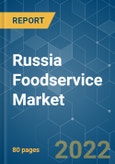The COVID19 outbreak significantly affected the market due to the closure of several quick-service and other restaurants, owing to the rules and regulations imposed by the government. Thus, this factor led to a decline in product sales as consumers’ movement was restricted during the pandemic. Starbucks, one of the major players in the industry, witnessed a decline in sales during the pandemic. According to the company, the major loss was due to the closures of its shops across the country.
Over the medium term, consumer demand for different delicacies may foster the market's growth, with increasingly busy schedules and rising household budgets. Growing promotional offers like happy hours and coupon discounts are also driving the market sales.
The increasing number of fast-food chains, cafes/bars, and other restaurants with unique, innovative formats, concepts, and services/delivery options also drives the market’s growth.
Key Market Trends
Increasing Prevalence of Eating/Dining Out
Due to the enhanced convenience in food consumption, there was a high preference for food outlets for breakfast, lunch, and dinner among those with busy lifestyles during the study period. According to the Russian Federal State Statistics Service, Russian households, on average, spend around 4.5% of their total expenditure on eating out. However, with the COVID-19 outbreak, the rate decreased to around 2.7% in 2020. Visiting a restaurant was the most expensive type of eating out in Russia, with an average consumer price of a meal for one person exceeding RUB 2.8 thousand in 2020. Russia is witnessing an increase in the number of food chain outlets, with more individuals preferring cuisines, meals, and dishes of other countries, like pancakes, burgers, sandwiches, pizza, and baked potatoes, thus driving the market’s sales.
Chained Consumer Foodservice Became the Fastest-growing Segment
Chained foodservice like fast-food restaurants and coffee houses/cafes are growing rapidly in Russia compared to fine dining and mid-range restaurants. Young and middle-aged consumers in Russia heavily purchase food from chained restaurants. Chained fast-food outlets are performing well in the country due to the overall popularity of franchising in Russia and the customers’ preference for well-known and consistent foodservice standards provided by chained outlets. Therefore, more global players are expanding into the market landscape. For instance, the number of Starbucks outlets in Russia grew from 106 in 2016 to around 146 in 2020.
Competitive Landscape
Major players in the Russian foodservice market include McDonald's, Yum! Brands RSC, Starbucks Coffee Company, Restaurant Brands International Inc., and Rosinter Restaurants. Chained food restaurants in Russia have been recording an increase in value sales by developing various outlets, thus increasing their presence. Companies are increasing their production capacities and expanding their distribution networks by signing contracts with logistics service providers to grow their business and gain a competitive advantage.
Additional Benefits:
- The market estimate (ME) sheet in Excel format
- 3 months of analyst support
This product will be delivered within 2 business days.
Table of Contents
Companies Mentioned (Partial List)
A selection of companies mentioned in this report includes, but is not limited to:
- McDonald's
- Yum! Brands RSC
- Restaurant Brands International Inc.
- Starbucks Coffee Company
- Wendy's Fast Food Restaurant Company
- Teremok
- Domino's Pizza Restaurant Company
- Papa John's Pizza
- Doctor's Associates Inc.
- Rosinter Restaurants








